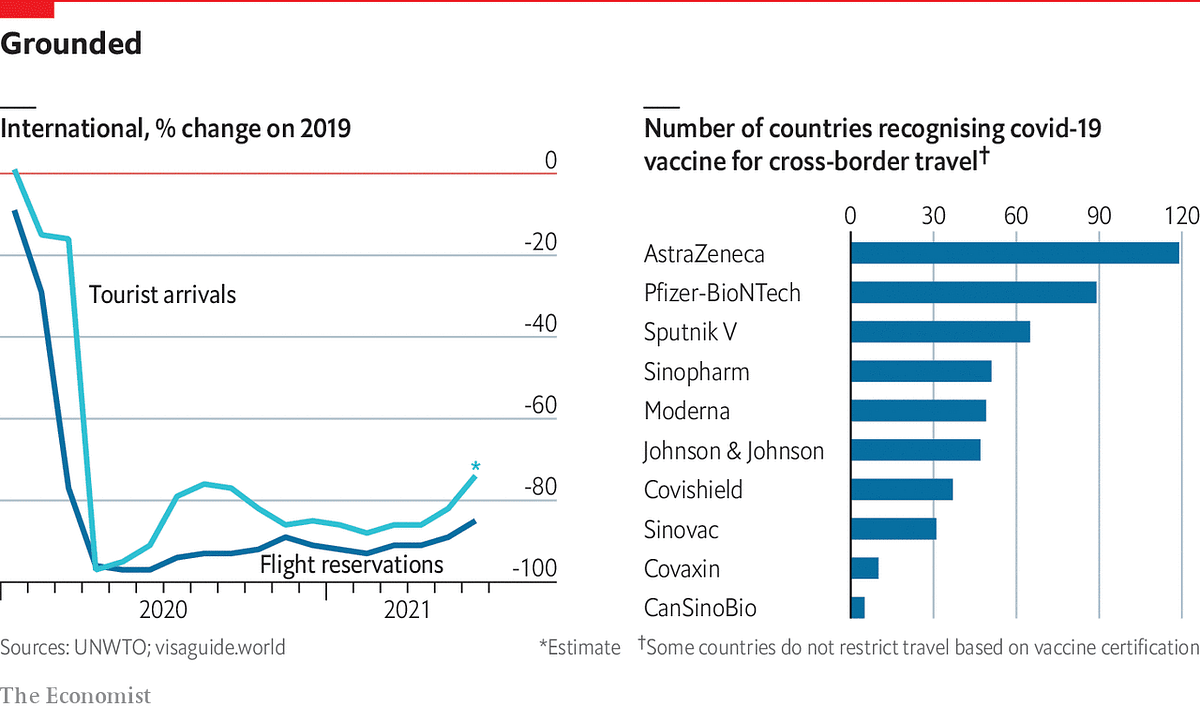The Economist
July 20, 2021.
Credit to the image: paho
PERHAPS THE best litmus test of the post-pandemic world will be how much international travel returns. In 2020 international tourism arrivals fell by 74% compared with 2019, to just 380m-by contrast the fall was just 4% during the financial crisis. In recent months international travel has begun to recover. With 3.7bn vaccine doses administered around the world, many people are raring to pack their bags for a foreign trip. But not every vaccine-acquired antibody automatically allows you freely to jet off overseas.
Many governments are welcoming only recipients of certain covid-19 vaccines as visitors. This month the European Union said it would not admit visitors who were jabbed with the Covishield vaccine-even though it is identical to the AstraZeneca vaccine which is used in the EU-because it has not been approved by the EU’s medicines regulator. The government of India, where the vaccine is manufactured, threatened to retaliate. The policy may also affect Covishield recipients elsewhere in the world: 5m doses have been delivered in Britain.
Data from VisaGuide.World, a travel website, demonstrate just how variable the patchwork of vaccine recognition is.
- The AstraZeneca vaccine is the most widely accepted, with 119 governments recognising it-it is the most-used vaccine and it is also approved by the World Health Organisation
- (along with Pfizer-BioNTech, Moderna, Johnson & Johnson and two Chinese vaccines).
- By contrast, China’s CanSinoBio is recognised by just a handful of governments (see right-hand chart).

The problem does not stop with travel. Although America is not requiring proof of vaccination for travel across its borders (they remain shut, however, to Brits, Europeans, Chinese and Indians, among other nationalities), Canadians who have received the AstraZeneca vaccine are worried they will be barred from entertainment venues that require FDA-approved vaccines for entry. America has ordered 300m doses of the AstraZeneca vaccine but has yet to approve it.
The travel industry is concerned that such restrictions will keep people at home. Nick Carreen of the International Air Transport Association, a trade group, says that the lack of agreement among governments is “one more hurdle to giving passengers confidence they can travel”. Mariangela Simao, an assistant director general at the WHO, says the European Parliament has recommended that countries consider accepting vaccines that have been emergency-listed by the WHO.
Over a dozen EU countries have since said they will ignore the EU rules and accept the Covishield vaccine as proof of immunity. But they are unlikely to be so easy on the Chinese vaccines. Although the Chinese ones have been given an emergency authorisation by WHO, there are gaps in the trial data for these jabs that are likely to worry some countries. Twelve million Chinese tourists visited the EU in 2019.
But a thumbs-up from the WHO is better than nothing. In the coming year it is likely that a number of vaccines will struggle to gain international recognition. For political reasons some countries have waved through home-grown, or -produced, vaccines through regulators. Others may not have stringent enough regulatory authorities to inspire confidence in medicines. Vaccines that are currently unlikely to get an easy ride from international authorities include Russia’s Sputnik V, India’s Covaxin and Cuba’s Abdala vaccine.
To make matters worse, a number of American states have enacted laws banning vaccine passports. These include Alabama, Arizona, Indiana and Florida. On July 13th, Norwegian Cruise Line Holdings sued the state of Florida over its laws preventing businesses from requiring customers to show proof of vaccination. As it stands, cruise ships will have trouble operating unless they can be certain that passengers are jabbed. For travellers and the tourist industry alike, 2021 is likely to be remembered for the continued covid-19 frustrations and border bureaucracy. The globetrotting and holiday snaps will have to wait until next year.
Originally published at https://www.economist.com on July 20, 2021.












